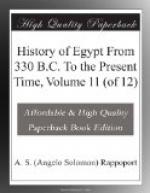Another heresy, which for a time made even as much noise as the last, was that of Hieracas of Leontopolis. Even in Egypt, where for two thousand years it had been the custom to make the bodies of the dead into mummies, to embalm them against the day of resurrection, a custom which had been usually practised by the Christians, this native Egyptian ventured to teach that nothing but the soul would rise from the dead, and that we must look forward to only a spiritual resurrection. Hieracas was a man of some learning, and, much to the vexation of those who opposed his arguments, he could repeat nearly the whole Bible by heart.
The Bishop Hesychius, the martyr in the late persecution, was one of the learned men of the time. He had published a new edition of the Septuagint Old Testament, and also of the New Testament. This edition was valued and chiefly used in Egypt, while that by Lucianus, who suffered in the same persecution, was read in Asia Minor from Constantinople to Antioch, and the older edition by Origen remained in use in Palestine. But such was the credit of Alexandria, as the chief seat of Christian learning, that distant churches sent there for copies of the Scriptures, foreign translations were mostly made from Alexandrian copies, and the greater number of Christians even now read the Bible according to the edition by Hesychius. We must, however, fear that these editors were by no means judicious in their labours.
[Illustration: 184.jpg DOME PALM OF UPPER EGYPT]
From the text itself we can learn that the early copiers of the Bible thought those manuscripts most valuable which were most full. Many a gloss and marginal note got written into the text. Their devotional feelings blinded their critical judgment; and they never ventured to put aside a modern addition as spurious. This mistaken view of their duty had of old guided the Hebrew copiers in Jerusalem; and though in Alexandria a juster criticism had been applied to the copies of Homer, it was not thought proper to use the same good sense when making copies of the Bible. So strong was the habit of grafting the additions into the text that the Greek translation became more copious than the Hebrew original, as the Latin soon afterwards became more copious than the Greek.
It was about this time, at least after Theodotion’s translation of Daniel had received the sanction of the Alexandrian church, and when the teachers of Christianity found willing hearers in every city of Egypt, that the Bible was translated into the language of the country. We have now parts of several Koptic versions. They are translated closely, and nearly word by word from the Greek; and, being meant for a people among whom that language had been spoken for centuries, about one word in five is Greek. The Thebaic and Bashmuric versions may have been translated from the edition by Hesychius; but the Koptic version seems older, and its value to the Biblical critic is very great, as it helps us, with the quotations in Origen and Clemens, to distinguish the edition of the sacred text which was then used in Alexandria, and is shown in the celebrated Vatican manuscript, from the later editions used afterwards in Constantinople and Italy, when Christian literature flourished in those countries.




